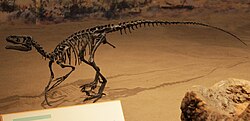Ornitholestes
|
Ornitholestes Temporal range: Late Jurassic, 154 Ma |
|
|---|---|
 |
|
| Skeleton mount, Royal Tyrrell Museum | |
| Scientific classification | |
| Kingdom: | Animalia |
| Phylum: | Chordata |
| Class: | Reptilia |
| Clade: | Dinosauria |
| Order: | Saurischia |
| Suborder: | Theropoda |
| Clade: | Tyrannoraptora |
| Subfamily: |
†Ornitholestinae Paul, 1988 |
| Genus: |
†Ornitholestes Osborn, 1903 |
| Type species | |
|
†Coelurus hermanni Osborn, 1903 |
|
Ornitholestes (meaning "bird robber") is a small theropod dinosaur of the late Jurassic (Brushy Basin Member of the Morrison Formation, middle Kimmeridgian age, about 154 million years ago) of Western Laurasia (the area that was to become North America).
To date, Ornitholestes is known only from a single partial skeleton with a badly crushed skull found at the Bone Cabin Quarry near Medicine Bow, Wyoming, in 1900. It was described by Henry Fairfield Osborn in 1903. An incomplete hand was later attributed to Ornitholestes, although it now appears to belong to Tanycolagreus. The type (and only known) species is O. hermanni. The specific name honors the American Museum of Natural History preparator Adam Hermann.
Ornitholestes was a bipedal carnivore. Its head was proportionally smaller than that of most other predatory dinosaurs, but the skull was heavily built, with a short snout and robust lower jaw. The orbits (eye sockets) were quite large, measuring over 25 percent of the skull's length. There is no indication of a bony eye ring.
The front teeth of Ornitholestes were somewhat conical, with reduced serrations; the back teeth were recurved and more sharply serrated, similar to those of other theropod dinosaurs. Henry Fairfield Osborn (1903) counted four teeth in the premaxilla, of which the front tooth was the largest in the upper jaw. In contrast, Gregory S. Paul (1988) depicted the skull with only three premaxillary teeth remaining, much smaller than those illustrated by Osborn. Each maxilla (main tooth-bearing bone in the upper jaw) contained ten teeth, and each dentary (tooth-bearing bone in the lower jaw) contained twelve teeth. The tooth rows of Ornitholestes were short, with the dentary (lower) row being even shorter than the maxillary (upper) row, even though the dentary bone itself was exceptionally long at the back, reaching a point below the middle of the eye socket. Teeth did not extend as far back as the orbits, and neither tooth row spanned much more than one-third of the skull.
...
Wikipedia
